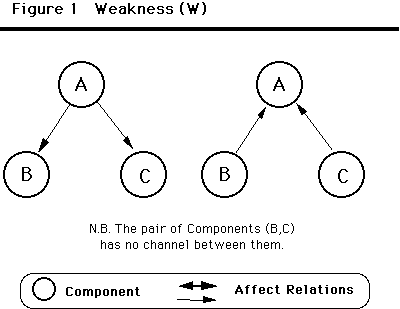 Educational Systems Theory
Educational Systems Theory
Property: Weakness (WE)
Definition:
- "Educational system weakness is not either complete connectedness or strongness or unilaterness and every two components are connected with respect to affect relations."
Comments:
- When two components are weakly connected, there is no channel between them, but one can get from one to another by ignoring the direction of the arrows. In weakly connected digraphs, every component has a channel to it or from it (i.e. no disconnecte
d components), but at least one pair of components has no channel between them. This implies that the system is neither completely connected, nor strong, or nor even unilateral.
Illustration:
- Note that components B and C have no channel between them.

Examples:
- In most public school classes, students listen to the teacher lecture, but are forbidden to talk with other. In this system, there are directed affect relations from the teacher to the students, but NO channels between students. Contrast this with a c
omputer mediated cooperative learning environment (e.g. Lotus Notes), where any pair of students might communicate to construct a document, say. Here anyone who is on-line is completely connected to all others, regardless of formal role. Similar patterns
of enforced individual isolation had been common at industrial production lines. It is interesting to note that the total quality movement (Demming et al) has reversed this pattern of isolated workers, who may only communicate with supervisors, in favor
of strongly connected teams. This is because managements have found it is impossible to achieve optimal quality using only weakly connected workers.
Related Terms:
- Affect Relation (def.)
- Component (Def.)
- Feedthrough (H #95, #101)
- Hierarchical Order (H #114)
- Flexibility (H #114)
- Size (H #177)
- Passive Dependence (H #177)
- Active Dependence (H #177)
Hypotheses Containing the Property: Weakness
- #95
- #101
- #114
- #177
Terms Similar to Weakness:
- Complete Connectedness
- Strongness
- Unilateralness
- Disconnectedness
Go to the top of this document.
 Go to SIGGS Home Page.
Go to SIGGS Home Page.
Last updated by John Beckerman,
4/4/95.
 Educational Systems Theory
Educational Systems Theory Educational Systems Theory
Educational Systems Theory
 Go to SIGGS Home Page.
Go to SIGGS Home Page.